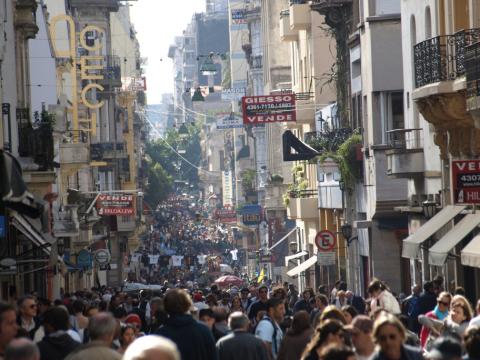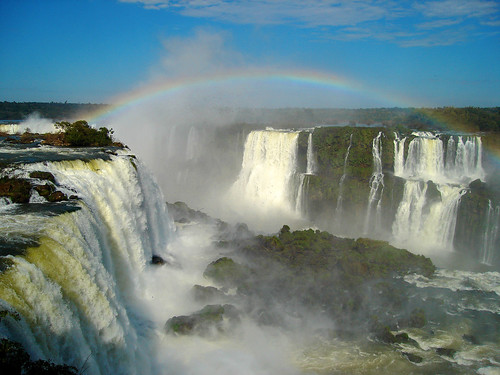The coach ride was surprisingly decent, considering its minuscule cost - the seats were spacious and fully reclineable, there was no erratic South American driving, the air conditioning worked and we were even given champagne with our evening meal. Walking around the prayer circle that had formed by the passengers, trying not to interrupt the spontaneous sermon that had taken place (presumably in thanks to have been delivered alive and safe against all odds at our destination) I took a breath of the thick morning city air and set about finding accommodation. Giuliana had previously been living in Buenos Aires and so had hooked me up with a hostel, Kilka, to stay in in San Telmo with a friend and seemed like a good place to start.
The famous San Telmo Markets
Bomba de Tiempo
Everyone at the hostel seemed to have incredible culinary prowess and people would come together to share meals in the evenings, from stuffed peppers with risotto to fresh salads and fish dishes, all accompanied with generous pours of beer. Keen to contribute, I went to the local supermarket 'Disco' (my favourite shop name in the city) by apt chance wearing my 'To the Disco' t-shirt, then the local grocery and bought some ingredients, followed by 4kgs of beef spine from the butcher down the street. Though I'd never cooked with this before, I soon had a gargantuan pot of aromatic bubbling beef soup (with shallots, potatoes, sweetcorn, carrots, celery, herbs, spices, and the secret ingredient - a bottle of Argentinian wine) and everyone sitting round the living room table slurping and drinking gave a great homely feeling this foreign land.
Two days were spent on walking tours around the city, soaking in some of the culture, history and sights of Buenos Aires with local guides. One striking thing about the capital is that it is so visually distinct from many other South American countries, particularly in terms of architecture. Many nations have clearly been influenced by colonial designs, but none in quite the same way as the Argentines. Brazil being the only nation on the continent involved in the Second World War, Argentina was able to capitalise by sending supplies to Europe, making vast sums of money, enough to afford to fill their would-be empty returning vessels with all the valuables they desired. This chiefly consisted of entire Parisian buildings, packed stone by stone, brick by brick, so many classic French and Italian buildings were sent across the Atlantic that in many areas of the city it is easy to think you are actually in the French capital. There also is a distinct disdain felt by other nations on the continent that Argentines are stuck up, thinking themselves as Europeans and therefore better than anyone else... which many Argentines shamelessly agree with.
Buenos Aires or Paris?
This pseudo-European nation is, however, more distinct from its colonial nations in appearance than it would be proud to admit, for there are far more areas full of smashed paving slabs, piles of rubble and huge heaps of litter that shelter thousands of homeless people across the capital than there are these lavish buildings. Amid the parts of society that have all too good a life, one that is obsessed with fashion and figures (100 breast implant operations are completed in this city everyday - more than anywhere else in the world), the other includes the thousands that rally in the 40 - 50 weekly protests near the Constitution Hall, people banging drums, blowing horns, waving flags and writing political graffiti as they protest about working rights, pay and government legislation.
Since the military junta ended in the early 80s, Argentina became a democracy, though the country is still clearly finding its feet in this regard, having no less than 5 different presidents between December 2001 and January 2002 as just one example, and of course, political corruption is still desperately rife. The populous are also passionate about using their rights to protest since the severely oppressive regime of the junta fell. During the late 70s and early 80s, congregating in the street in groups of more than 3 was an arrestable offense, as was being suspected of revolutionary thinking - arrests that saw the 'disappearance' of 30,000 of residents - men, women and children, almost all of whom were likely to have been murdered by the state. The mothers of the lost children are still campaigning for the people in their 20s and 30s to get DNA testing as many children who were due to be executed were secretly adopted by their captors - controversially, over 100 children have discovered that, not only were they adopted, but their supposed parents had probably been directly, or at least indirectly been involved in the murder of their biological parents.
On the tour, we went on to visit the Big Ben style clock in the city - a gift from the old British rail workers - and the Falklands... sorry, ahem, the Malvinas war memorial directly opposite, commemorating nearly 700 Argentinian soldiers that fell in the war. They say they built it in front of the clock so they could 'keep an eye on us'... The antithesis to this sorry affair however, is that the war greatly expediated the fall of the repressive junta which liberated the nation from tyranny and feel less guilty about quietly humming Land of Hope and Glory at the monument. Perhaps if they weren't still so touchy about it I may not be so conceited...
The British Clock Tower - modelled on Big Ben
Don't mention the war...
The 16th of April was my last night in South America and I wanted to do it in true Argentinian style. I called Amanda, the first person who met me at Casa 579 and showed me the ropes of the guest house before moving from Rio back to her home city to study, and arranged to meet. It happened to be her mother's birthday, so 8 - 11pm consisted of eating and drinking with Amanda, her mother and a dozen of her friends, all drinking wine and all speaking very fast Spanish all at once. My abilities in Portuguese meant I was able to understand some of what they said (there is a significant overlap between the two languages) though still managed to cause some laughs as I struggled with the differences - 'Thank you' in Portuguese is 'Obrigado' and in Spanish is 'Gracias', and my accidental amalgamation would embarrassingly conjure 'Obri-gracias'. Fluent 'Portaniol', I've been assured.
Amanda's friend Maria was meant to meet us so we could leave for midnight (like the Spanish, the Argentines start nights out late), but though the international female phrase, 'I'll be ready in 5 minutes' always tells the seasoned male that pigs will sooner fly than 5 minutes being accurate, one cannot be prepared for the habbits of Argentine women. At 2am and another assurance of 'just 5 more minutes', my forehead was reddening from the banging of it on a wall. At just after 3am, when we finally left, I was told things are still just getting started at local bars and clubs, followed by Amanda's wonderful insight of local female time keeping, "If we're only an hour late then we're on time - three hours late is pushing it a little". Classic Latin America! As much as I jest about their time keeping, Amanda and Maria were great fun to go out with. We drank great wines and beers in local bars, made new friends and partied well past sunrise, all in time to have breakfast, send Amanda home to sleep and for me to go to the airport for my midday flight (which I was sure to sleep through, running on fumes for the rest of the morning)
Amanda, random Argentine & Lionel drinking some good old Malbec













